
From Call of Cthulhu, Alone in the Dark to Eternal Darkness, in Meristation we review some of the titles that have taken part in the Lovecraft universe
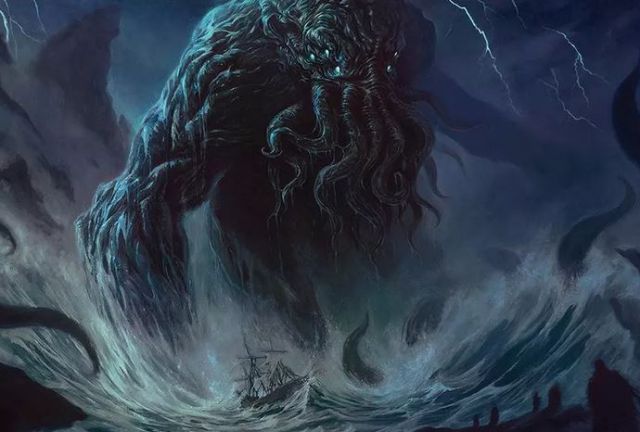
“The oldest and most intense emotion of humanity is fear, and the oldest and most intense of fears is the fear of the unknown”
Howard Philips Lovecraft
Fear of the unknown, of other forces from another dimension, of the immensity of the sea, to the point of questioning human understanding and the limits that separate sanity from madness. From this concept comes the cosmic or Lovecraftian terror, a subgenre of terror created by the master Howard Philips Lovecraft, who has gifted us with some of the most influential literary stories of the 20th century. Putting yourself in the role of the crazy mind of the writer is not an easy task, and in fact, if we are somewhat strict, we can say that only a few titles have managed to capture their universe successfully.
We have heard much about Lovecraft, but little about the meaning of cosmic terror that the writings of the author usually display. When we talk about cosmic terror, we must understand that it is such a broad, complex and abstract concept that it is even difficult to describe. Cosmic terror tries to find those moments when the unknown collides with the known. It is that animal, existential fear that we have all felt at some time and that we have been unable to explain. It is the sensation of observing the sky and the open sea and that makes us feel powerless. That’s why a good cosmic horror story plays on that fear, leading us to a surprising encounter with the ocean – and its unpronounceable word Cthulhu – where it forces us to confront ourselves and the vast cosmic forces that shape humanity. In fact, if we thought that having control over our natural world is easy, the cosmic horror will make us question once, twice and even three times if necessary.
One thing we can affirm is that the universe created by the writer from Providence (Rhode Island) is still raging today. This is so. With this, he has left us great titles based directly on his stories, and many others that have been inspired only by some of them. From Call of Cthulhu, Alone in the Dark to Eternal Darkness, in Meristation we review some of the titles that have taken part of the Lovecraft universe in the sector that concerns us, what will it be but, the video game.
Bloodborne (2015)
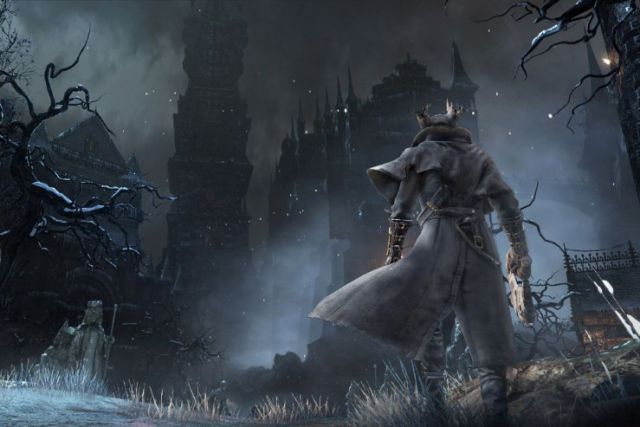
Hunted hunter
Our beloved Yharnam places us on a stage set in the Victorian era, and we could say that a large part of her scenery could be perfectly inspired by many of Lovecraft’s iconic stories. Although in this case precisely it goes much further than its staging, since in it they raise two interesting principles such as the use of mythology and the concept of frenzy. Bloodborne mythology includes with it its own gods, gods who act as they please and where our character is just a small piece of that puzzle. Analogy that could be likened to the author’s concept of deities with their own gods (from Azathoth, Hastu, Yog-Soggoth, Shub-Niggurath to Nyarlathotep) operating on a plane superior to that of any other race.
“Someday our rebuilding of knowledge will open up such terrifying prospects that we will either go insane or flee to the safety of a new dark age.”
Howard Philips Lovecraft
Another parallel of Bloodborne with Lovecraft is found with the use of frenzy. This makes our hunter lose consciousness or die and wake up again in sleep. It is the mere customization of the blasphemous surviving nightmares in Bloodborne that drives the hunter crazy. Doesn’t it make sense to continue if the end is the beginning and time is an infinite loop? The hunter is dead? Will our nightmare ever end? Ideas such as awakening from sleep, beasts that escape human reason, loss of consciousness, the presence of the nightmare moon (and its analogy to the “crawling chaos” called Nyarlathotep by the author) and being ultimately at the mercy of primal deities, makes Bloodborne very close to the universe described by the classic author. A tribute to the writer based on the Dark Souls franchise, giving rise to a brother of the saga with all the flavor of the master of Providence.
The Sinking City (2019)
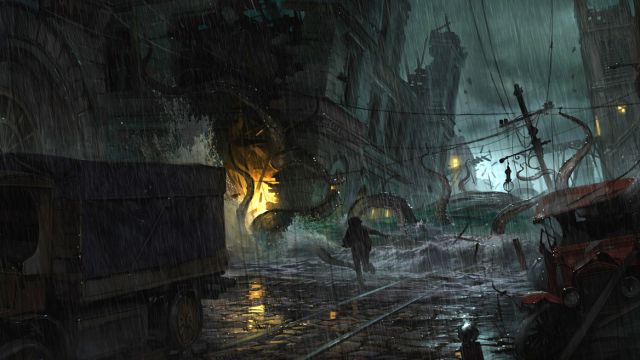
If we had to mention one of the most representative titles of the Lovecraft universe, without a doubt we have to talk about The Sinking City. This in fact could be one of the most Lovecraftian games to date followed by Call of Cthulhu. Based on his work “Myths of Cthulhu”, its plot takes place in England in the early 1920s, putting us in the shoes of private detective Charles W. Reed. After a series of strange cases of disappearances in Oakmont, Massachusetts, the city has suffered a constant flood for some time that has isolated it from the rest of civilization completely. His narrative sets foot in the religious cults habitually coined by the author, together with the presence of gods – with long tentacles – ready to carry out chaos and destruction.
One of the interesting aspects of the game is how it introduces the concept of madness, a gradual mechanic accompanied by visions that our protagonist suffers. The Ukrainian studio Frogwares made sure to pay a clear tribute to the author (including his own Cthulhu) as well as draw inspiration from the town described by the author as “Innsmouth” in his original work Cthulhu Mythos, include clear references to their gods, and capture one of his most recurrent fears: “The immensity of the sea.”
“Men of the broadest mind know that there is no clear distinction between the real and the unreal; that all things seem what they seem only by virtue of the delicate psychic and mental instruments of each individual, thanks to which we come to know them “
Howard Philips Lovecraft
Darkest dungeon (2015)
Let’s take a look at the definition of insanity. See this as: “pathological disorder or disturbance of mental faculties.” The author was passionate about this medical-scientific aspect, being one of his usual themes in many of his stories. The psychiatric admission of his father marked the writer’s childhood, turning to the concept and studying it practically his entire life. In this case, Darkest Dungeon treats insanity from another usual perspective. The title is a goth aesthetic RPG with enough maddening moments where we lose our characters’ sanity as we move through the darkness. The game begins when our character inherits the mansion of a distant relative who had supposedly gone mad in it, and our mission will be to visit the dungeons. Darkest Dungeon is not only “Lovecraftian” in appearance, it goes beyond that. The mechanics of the game itself are based on themes that are integral to Lovecraft’s particular type of horror: fear, madness, and the evil forces that reside in darkness. Although not only his mechanics alluded to Lovecraft, but also his enemies, making direct mention of the creatures that we found in his works “Herbert West-Reanimator”, “The Dunwich Horror” and “The outsider”. The result of the title is an experience that can be highly rewarding and unsettling at the same time, and something the author would surely be more than proud of.
Call of Cthulhu (2018)

Throughout history, human beings have feared the dark and for Lovecraft it represented the unknown and the unknowable. Many of his stories focus on forbidden lore hidden in the dark, in particular his work The Call of Cthulhu. The 2018 game is without a doubt one of the most remembered adaptations of Cthulhu to date, and is arguably the most iconic title based on the Lovecraft universe. This time around, we dive into a first-person investigative and puzzle story as veteran private detective Edward Pierce.
Our mission in Call of Cthulhu will be to decipher a mysterious death that occurred in the Hawkins family mansion and reveal some of the strange events that happen on the fishing island Darkwater. The story of the video game captures the essence of his original work, with a dark atmosphere and intense psychological horror, which ends up taking a toll on the protagonist himself. The game has obvious Lovecraftian intentions: a main character tortured to the brink of insanity, role-playing skill trees inspired by the original Call of Cthulhu pencil and paper game, enemies based on the “Primeval Gods” and references to works such as “Shadow Over Innsmouth ”and“ Pickman Model ”. This time we are facing a Lovecraft story associated with the sea -and its dark fauna-, centered on the fire that occurred in a mansion that is still on the misty island of Darkwater.
“Who knows the end? What has emerged can sink and what has sunk can emerge. The satanic awaits dreaming at the bottom of the sea, and the apocalypse sails over the undulating human cities”
Howard Philips Lovecraft
Amnesia: The dark descent (2010)
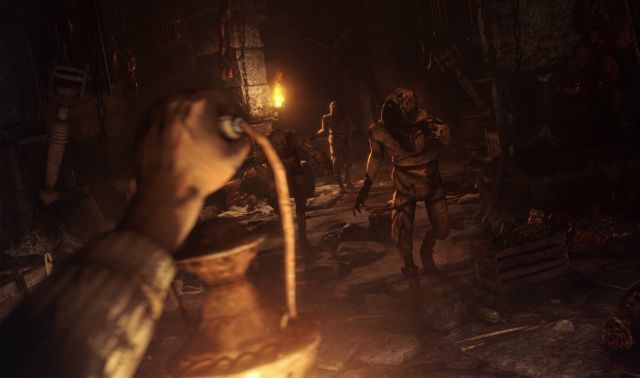
Terror in the face of absolute darkness with a lantern in hand. In Amnesia: The dark descent we find many influences from Providence’s cosmic horror master. Our main character in the game, Daniel, wakes up in Brennenburg Castle without remembering anything else (hence his name Amnesia) and must go through it to get to its darkest secrets within the sanctuary. This fact allows us as a player to share the confusion and horror of our protagonist as the game unfolds. An argument that alludes to the author’s book “Rats on the Walls” from 1923.
As in many of Lovecraft’s texts, fear does not come directly from what we see, but from what we ourselves create in our mind. At Amnesia we hear and feel our enemies with one main characteristic: we don’t see them first. From this idea they start from many concepts that the author avoids in all his stories; focused on the most primitive terror along with the loss of sanity that comes with it. We can’t talk about Amnesia without mentioning her sanity meter, a staple of Lovecraftian horror. The title’s sanity meter provides an excellent representation of the psychological instability seen in many of Lovecraft’s works and explicitly incorporates it as a game mechanic. With this preamble, many followers saw clear references to Lovecraft in Amnesia, so much so that it did not take long for his own fandom to fall on him. An example we have with The Shadow of the Ramlord, a mod built from the resources of The Dark Descent and its sequel, Amnesia: A Machine of Pigs. Which, of course, was also a Lovecraftian adventure.
Alone in the dark (1992)
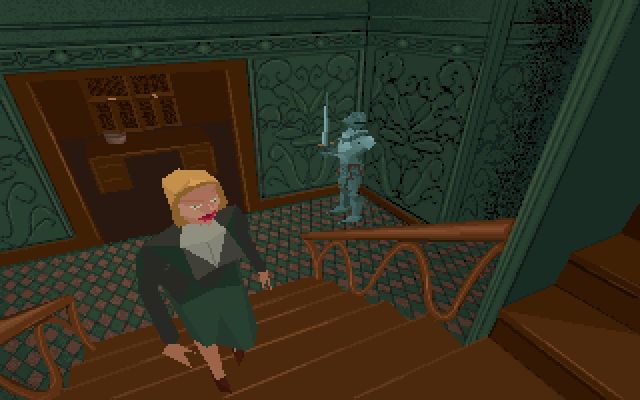
Neither PT nor RE7, this was really fear in its time
Released by the Infogrames company, Alone in the dark placed us in the 1920s, the era of Lovecraft himself and most of his stories. With our arrival at the Derceto mansion, we played Edward Carnby or Emily Hartwood to discover the strange events that happened in it. In 1992 we experienced something revealing with its staging and its transgressive use of 3D. A window broke and suddenly a strange being emerged from the darkness and swayed on top of our character, immersing us in a unique and terrifying atmosphere for its time. In Alone in the Dark, in essence, we had to solve puzzles through objects that we obtained when searching the mansion. Except instead of getting stuck for hours like most titles of the time, we ended up dying. The direction in which the plot takes us leads us directly under the influence of Lovecraft’s works, where we will find different occult practices, enemies inspired by the races of “The Deep ones” or the “Chthonian” created by HP Lovecraft, even making a direct allusion to some of his stories and books such as “Necronomicon” and “Vermis Mysteriis”.
Call Of Cthulhu: Dark Corners of the Death (2005)
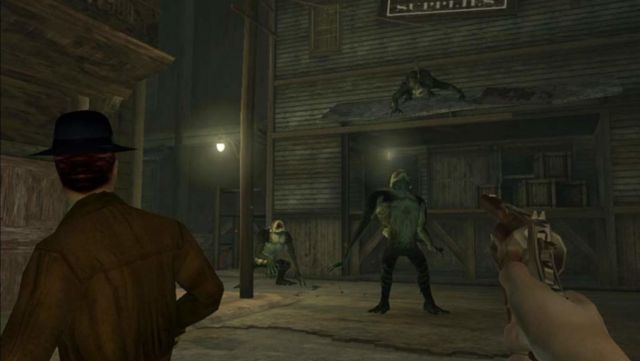
Despite the fact that the prestigious master of cosmic horror was the author of some of the most disturbing stories of the 20th century, for a long time his works remained ungodly in video games. Right in the late 90s, very few titles had been based directly on Lovecraft’s writing until the arrival of Call of Cthulhu: Dark Corners Of The Earth. The title places us in the year 1915, putting us in the hands of police detective Jack Walters to investigate a cultist mansion. A few years later, our protagonist wakes up in a madhouse with no memories of the last 6 years. After being released, we resumed private investigation and a job to find a missing person in the city of Innsmouth.
As events spiral out of control and city dwellers become “somewhat violent,” our protagonist discovers that this case actually shares a connection to his own past. In the title we find a whole arsenal of nightmare creatures, and the more we look at them or find them, the more our sanity will fall. This fact will directly affect Jack’s vision, which will become increasingly blurred, until it reaches madness and the uncontrollable suicide of our own protagonist. Dark Corners of Earth brings to the table the most existential and esoteric themes of Lovecraft’s work, such as the origins of humanity, sorcery, and the extra-dimensional horrors guided by other Gods. Again, key resources from the Lovecraft universe.
Eternal darkness (2002)
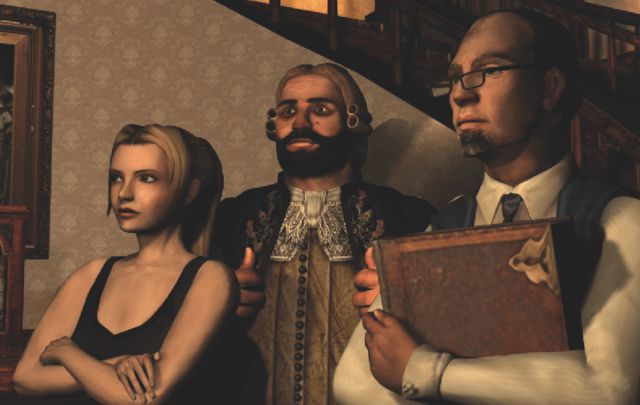
Eternal Darkness, great GameCube game (nostalgic tear)
In 2002 we had Eternal Darkness, a GameCube game that is considered today one of the great references of the Lovecraft universe. The title presents us with a story told discontinuously by different characters and that takes place over thousands of years. It is a series of interconnected stories, which may even recall the classic tales of Edgar Allan Poe, which intertwine myth, the occult and some of the darkest episodes of religion. The title is based on Lovecraft’s concept of the so-called “Ancients.” Both in the myths of the literary master and in the video game, they are gods prior to the appearance of man, apparently trapped in other dimensions and altering the course of humanity in their own way.
The main action of the video game takes place in Rhode Island, and in fact it is no coincidence since the author was an original from there. One of the main mechanics of the game is the madness meter, in addition to having a story arc based on historical elements and the consequent reign of terror that victimizes multiple generations of characters. As sanity diminishes, the world begins to crumble around him, along with that of the player himself who is playing. The factual background intensifies the understanding that historical horrors are even more terrible than fictional ones, and in fact in this case, we do not take your reason.
Call of Cthulhu: Shadow of the Comet (1993)
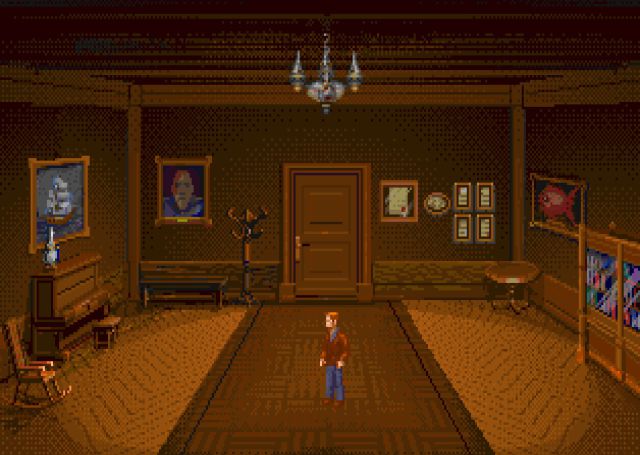
Lovecraft’s stories were fueled by one of the most basic and incomprehensible human fears for both science and religion. Many of his works are classified as the Cthulhu Mythos, connected works of fiction about a series of indescribably grotesque deities, much older than humanity, who are simply biding their time to rule the world for themselves. Many of its short stories revolve around a normal person who somehow runs into one of these abominations, or perhaps cultists who worship them, and is driven insane. On this occasion, their two games, Shadow of the Comet (and its second installment) Prisoner of Ice, were not explicitly based on any Lovecraft story, although they brought together very specific elements for both, and any fan today could recognize their influences. Shadow of the Comet is a point-n-click that focuses on Halley’s Comet, one of the best-known astronomical phenomena, which appears visible from Earth once every 75 years.
The game takes place in 1910. A reporter named John Parker goes to the city of Illsmouth, to be able to photograph the comet in action, and to know the whereabouts of the scientist Lord Boleskine. Our protagonist sets off to cross the Atlantic to closely follow in Boleskine’s footsteps, with some impediments in between; For the most part, anyone who knows him is dead, insane, or just refusing to talk about him. The town of Illsmouth is a direct reference to Innsmouth, from “The Shadow over Innsmouth”, one of the author’s most iconic stories and one of the central elements of the Cthulhu myth. We also find similarities with its second part, Prisoner of Ice, a point-n-click of a new work by Infogrames (parents of Alone in the Dark) that takes place in Antarctica, based on their work “Polaris”, as well as being inspired by other stories such as “The temple”, “In the mountains of madness” and “Necronomicon”.
SOMA (2015)
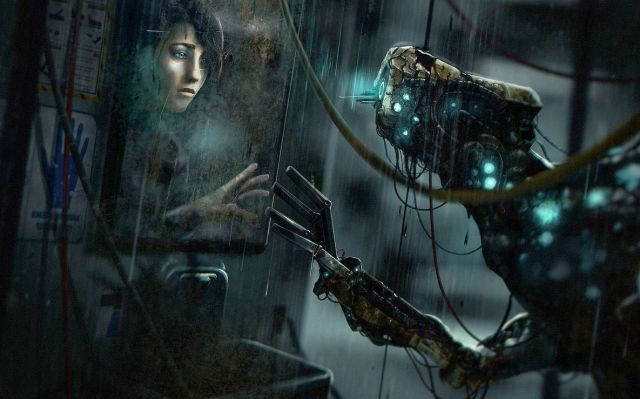
A “deus ex machina” with Lovecraftian overtones
Thomas Grip (Creator of Soma): “… just as Lovecraft was inspired by the science that was happening at that time, SOMA is also inspired to some extent by the science that is happening at that time: neurology, machine learning, artificial intelligence and all that.”
Many of Lovecraft’s stories were based on the new science of the day: physics and cosmology. In this case, Soma raises the same concept, but elevated to the most recent science, focused on advances in neurology, psychology, and artificial intelligence. The title sports science fiction influences typical of Asimov or Philip K. Dick, and of course Lovecraft could not be absent. Soma brings us closer to his main concern embodied in his work “The Whisperer in the Darkness”. A psychological horror game under the sea, dominated by intelligent machines in the style of “Deus ex machina” that will try to hunt us down. Like Lovecraft’s creations, one does not fight against their gods, but must avoid them, ducking in the shadows and trying to keep our sanity at all times (if we can of course).
Sherlock Holmes: The Awakened (2007)
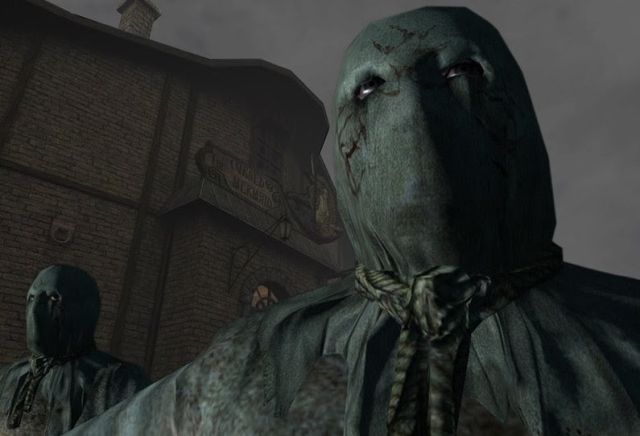
Elemental dear watson
His name is Holmes, Sherlock Holmes. Yes, we can say that one of the best known Baker Street detectives has also based some of his video games on the Lovecraft universe. This time it’s Sherlock Holmes: The Awakened. Our protagonist does not need presentations, and in particular, his plot focuses on addressing one of the most complex cases he has ever solved (as usual). After investigating a series of kidnappings, he discovers that they appear to be linked to a cult attempting to summon Cthulhu. Suddenly, you will not only have to save 19th century London, but the whole world as well. The Frogwares studio decided not to focus on the Lovecraftian creature we all know, but rather on the forbidden cult. A good title that left us with a pleasant Lovecraftian experience under a fearful atmosphere at the hands of the best detective of all time.
Not only here does the Providence master’s universe conclude. Many titles have been part of its universe, although some more than others have more or less evidenced their influences: Dark seed, The Lurking Horror, Stygian: Reign of the Old Ones, Necronomicon, Clive Berkers Undying, Conarium, Mans of Madness, Clive Berkers Undying to the current Cthulhu Save the Christmas, among many others. Which one do you choose?

